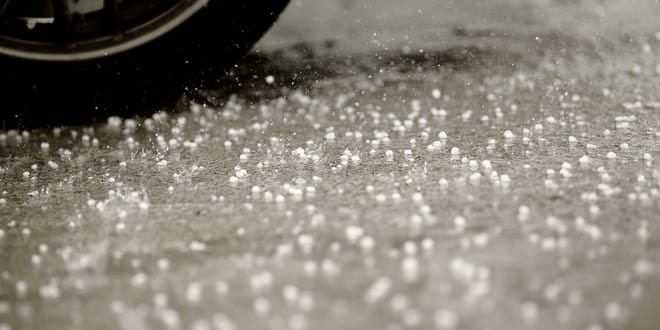The Denver metropolitan area experienced an intense hail storm Thursday, which led to the largest hailstones recorded in the county in 35 years. The National Weather Service (NWS) issued a ‘destructive’ severe thunderstorm warning for the Denver area. Baseball-sized hail and wind gusts up to 50 mph were reported, with accumulations of 2.75 inches. Damage to vehicles, homes, and trees was also reported in many locations.
HOLY HELL.
— Danielle Grant (@theWXwoman) May 31, 2024
Golf balls in NE #Denver!
🚨#BREAKING: A destructive hailstorm ranging from tennis balls to baseballs are falling, heading towards the Denver International Airport with reports of significant damage⁰⁰📌#Denver | #Colorado ⁰⁰Currently, the National Weather Service in Boulder, Colorado, has issued… pic.twitter.com/ezEBnkeR7t
— R A W S A L E R T S (@rawsalerts) May 31, 2024
Unpredictable weather conditions continued to affect the area, with additional hailstorms striking on Saturday afternoon.
Record-breaking hailstorms in recent years have sparked serious speculation about the influence of climate change on their intensity and frequency. Last August, a 6.2-inch (16-centimeter) hailstone fell in Italy, setting a new European record. Just five days later, another ball of ice with a diameter of 7.6 inches (19.46 cm) shattered that record. In 2010, a hailstone eight inches (20.3 cm) in diameter—almost as large as a bowling ball- fell in South Dakota, nearly breaking the world record. These events underscore the urgent need to address climate change on a global scale. In Texas, Colorado and Alabama the records for the largest hailstone have been broken in the last three years, reaching sizes of up to 16cm (6.2 inches) in diameter. In 2020, Tripoli, the capital of Libya, was struck by hailstones nearly 18cm (7.1in) across.
When speculation about possible global warming began a decade ago, some believed that warming weather would cause hail storms to become more rare. But meteorologists report that hailstorms have become more common and more intense.
An article in Scientific American last year suggested a reason for this.
“Hail-producing thunderstorms have three ingredients,” Katja Friedrich, an atmospheric scientist at the University of Colorado Boulder, explained. “Strong updrafts (warm, rising air that fuels the storm); an unstable atmosphere (which happens when there is a cold, dry air layer over a warm, wet one); and abundant atmospheric moisture.”
She explained that warmer air holds more moisture and how fast a hailstone grows depends on the amount of moisture in the air. Warming near Earth’s surface contributes to atmospheric instability, which can promote more storms. Updrafts are crucial to forming hailstones, which start as tiny ice particles that researchers call embryos.
Indeed, intense hail storms have become common in the summer. In July 2021, golf ball-sized hailstones pelted the Midlands of England during a heatwave with disastrous results. Even larger hailstones pelted Calgary, Canada in June 2020 causing $940 million in damage. Statistics show an increase in the number of large hailstones in the United States over the past two years.
While the Biblical Exodus from Egypt was preceded by a catastrophic hailstorm, last week’s ice storm in Colorado fell short of the seventh plague. The Bible describes the hailstorm that struck Egypt as including a mixture of fire and ice.
The hail was very heavy—fire flashing in the midst of the hail—such as had not fallen on the land of Egypt since it had become a nation. Exodus 9:24
Indeed, increasing hailstorms replaying the Egyptian plague may be setting the stage for the Final Redemption. Jewish sources predict that all of the plagues will reappear in the final Redemption but in even more powerful forms. It is written in Midrash Tanchuma, homiletic teachings collected around the fifth century, that “just as God struck the Egyptians with 10 plagues, so too He will strike the enemies of the Jewish people at the time of the Redemption.”
This concept was explained by Rabbi Bahya ben Asher, a 13th-century Spanish commentator, who wrote, “In Egypt, God used only part of His strength. When the final redemption comes, God will show much, much more of His power.”
The Israel Bible poignantly explains why the seventh plague, a combination of fire and ice, is appropriate for our turbulent times.
“The hail contains both fire and ice, yet the fire does not melt the ice and the water of the ice does not extinguish the fire. They are able to exist in harmony for the purpose of fulfilling God’s will. Similarly, the medieval commentator Rashi comments (Gen. 1:8) that the Hebrew word for heaven, ‘shamayim,’ comes from the Hebrew words ‘aish’ (fire) and ‘mayim’ (water), as the two came together in harmony to make up the heavens. This serves as a powerful lesson of peace and is referenced in the daily Jewish prayer service. The following supplication appears multiple times in the liturgy: ‘He Who makes peace in His heights (between fire and water), may He make peace, upon us and upon all Israel.’”






